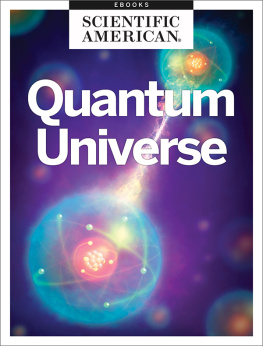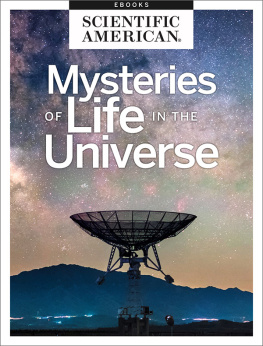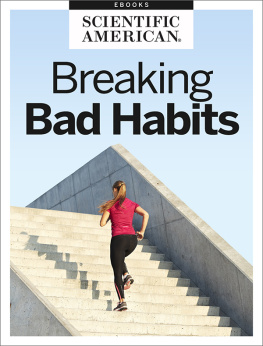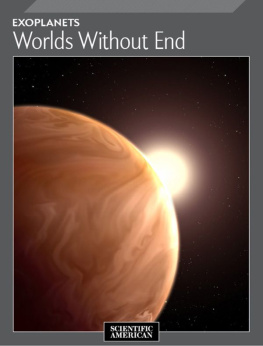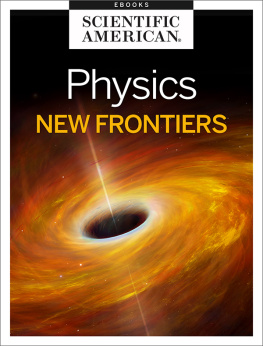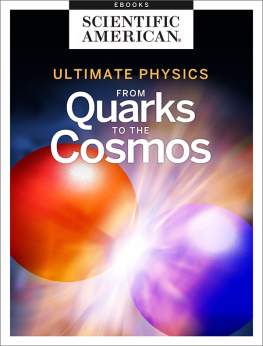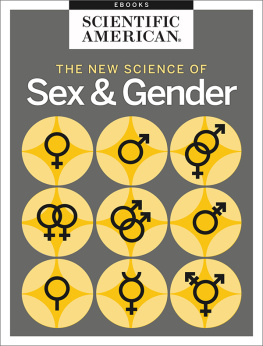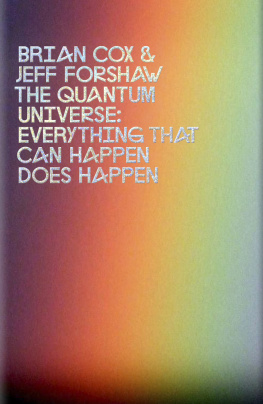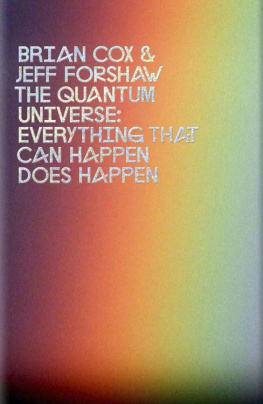Scientific American Editors - Quantum Universe
Here you can read online Scientific American Editors - Quantum Universe full text of the book (entire story) in english for free. Download pdf and epub, get meaning, cover and reviews about this ebook. year: 2020, publisher: The Rosen Publishing Group, Inc, genre: Romance novel. Description of the work, (preface) as well as reviews are available. Best literature library LitArk.com created for fans of good reading and offers a wide selection of genres:
Romance novel
Science fiction
Adventure
Detective
Science
History
Home and family
Prose
Art
Politics
Computer
Non-fiction
Religion
Business
Children
Humor
Choose a favorite category and find really read worthwhile books. Enjoy immersion in the world of imagination, feel the emotions of the characters or learn something new for yourself, make an fascinating discovery.
- Book:Quantum Universe
- Author:
- Publisher:The Rosen Publishing Group, Inc
- Genre:
- Year:2020
- Rating:5 / 5
- Favourites:Add to favourites
- Your mark:
- 100
- 1
- 2
- 3
- 4
- 5
Quantum Universe: summary, description and annotation
We offer to read an annotation, description, summary or preface (depends on what the author of the book "Quantum Universe" wrote himself). If you haven't found the necessary information about the book — write in the comments, we will try to find it.
Scientific American Editors: author's other books
Who wrote Quantum Universe? Find out the surname, the name of the author of the book and a list of all author's works by series.
Quantum Universe — read online for free the complete book (whole text) full work
Below is the text of the book, divided by pages. System saving the place of the last page read, allows you to conveniently read the book "Quantum Universe" online for free, without having to search again every time where you left off. Put a bookmark, and you can go to the page where you finished reading at any time.
Font size:
Interval:
Bookmark:

Quantum Universe
From the Editors of Scientific American
Cover Image: Mark Garlick/GettyImages
Letters to the Editor
Scientific American
One New York Plaza
Suite 4500
New York, NY 10004-1562
or editors@sciam.com
Copyright 2020 Scientific American, a division of Springer Nature America, Inc.
All rights reserved.
Published by Scientific American
www.scientificamerican.com
ISBN: 978-1-948933-20-9


QUANTUM UNIVERSE
From the Editors of Scientific American
Table of Contents
Introductionby Andrea Gawrylewski
Section 1
1.1
by Lee Smolin
1.2
by Sabine Hossenfelder
1.3
by George Musser
1.4
by Ronald Hanson & Krister Shalm
1.5
by Toby S. Cubitt, David Perez-Garcia and Michael M. Wolf
1.6
by Tim Folger
Section 2
2.1
by Brian Koberlein
2.2
by Philip Ball
2.3
by Tim Folger
2.4
by Anil Ananthaswamy
2.5
by Karmela Padavic-Callaghan
Section 3
3.1
by Steven B. Giddings
3.2
by Yasunori Nomura
Section 4
4.1
by Michael Brooks
4.2
by Anil Ananthaswamy
4.3
by Urbasi Sinha
4.4
by Lee Billings
4.5
by Elizabeth Gibney
4.6
by Charlie Wood
On the Heels of a Light Beam
As a 16-year-old boy, Albert Einstein imagined chasing after a beam of light in the vacuum of space. He mused on that vision for years, turning it over in his mind, asking questions about the relation between himself and the beam. Those mental investigations eventually led him to his special theory of relativity. Such thought experiments, which Einstein referred to by the German term gedankenexperiment, continue to nourish the heart of physics today, especially in the field of quantum mechanics, which he helped to establish.
In quantum mechanics, things dont happen, theoretical physicist Stephen L. Adler tells our reporter Tim Folger, referring to the probabilistic nature of quantum reality.
Philosophically, this may be true, but it hasnt stopped researchers from testing quantum concepts. Using lasers to excite electrons into emitting photons, a group at Delft University of Technology in the Netherlands ruled out the existence of hidden variables, which Einstein believed were controlling so-called entangled particlesone of the main tenets of quantum theory. Without these mysterious forces, bizarre dynamics could indeed be at work in the quantum world, defying our notions of space and time. Physicist Lee Smolin argues that the fabric of the cosmos is a vast collection of atomic interactions within an evolving net- work of relations where causality among events is complex and irrespective of distance.
Despite the theoretical mysteries of quantum theory, its real-world applications are growing. Researchers are cooling atomic systems to near absolute zero for use as quantum simulators to study applications in superconductors and superfluids. Others are using table-top experiments to monitor the gravitational fields around entangled objectsminuscule gold or diamond spheres, for examplelooking for signs that gravity itself is quantized into discrete bits. At a larger scale, tools such as the Event Horizon Telescope, which recently took the first picture of a black hole, and gravitational-wave detectors could help resolve long-standing, vexing contradictions between quantum mechanics and general relativity.
These quantum insights are fueling tremendous innovation. A team of researchers in China successfully tested superposition over a distance of 1,200 kilometers, paving the way for an unhackable quantum-communications network. Computer scientists are using quantum algorithms to enhance traditional systems, ratcheting up progress toward the heralded quantum computing era. Such applications are still immature, as Elizabeth Gibney reports, yet its not stopping investors from pouring money into quantum start-ups.
Science historians have argued about whether Einstein accepted the elements of quantum theory that conflicted with his own theories. Who knows whether he could have imagined the applications his ideas engendered. In any case, the thought experiment continues.
--Andrea Gawrylewski
Senior Editor, Collections
Space: The Final Illusion
by Lee Smolin
Many of the great advances in science are marked bythe discovery that an aspect of nature we thought was fundamentalis actually an illusion, the result of the coarseness of our sensoryperceptions. Thus, air and water appear to us to be continuous fluids,but we discover on deeper experiment that they are made ofatoms. Earth appears to us motionless, but a deeper understandingteaches us that it moves relative to the sun and the galaxy.
One persistent illusion is that physical objects only interactwith other objects they are close to. This is called the principleof locality. We can express this idea more precisely by thelaw that the strength of forces between any two objects fallsoff quicklyat least by some power of the distance betweenthem. This can be explained by positing that the bodies donot interact directly but only through the mediation of a field,such as an electromagnetic field, which propagates from onebody to the other. Fields spread out as they propagate, with thefield lines covering a constantly greater areaproviding anatural explanation for the laws that say the forces betweencharges and masses fall off like the square of the distancebetween them.
Locality is an aspect of an even more compelling illusion:that we exist within an absolute space, with respect to which wemark our positions as we move through it. Thus, Isaac Newtonopined that motion is ultimately defined as change of positionwith respect to absolute space. If this seems obscurebecause no measurement can establish a relation of a physicalobject to this imagined absolute spaceNewton assured us thatabsolute space is seen by God, making your location relative toit an aspect of the divinity of the world. We humans must makedo with relative positions and motionswhich are defined relativeto physical objects we can see.
Gottfried Wilhelm Leibniz broke the mystification by declaringthat all that exists is relative positions and motions. He proposedas a matter of principle that any acceptable science ofmotion must be formulated in terms of relative motions alone.And this, after two centuries of waiting, is what Albert Einsteindelivered to us in his general theory of relativity. In this gloriousconstruction, space is subsumed into spacetime, which isexplicable as a dynamically evolving network of relations.
And what defines those relations? Nothing but causality. Theelements of spacetime are eventsthe ultimate expression oflocalityand each of these is caused by events in their past.Each event will also become a cause of events in the future.Most of the information in the geometry of spacetime is actuallya coding of the relations of causality that relate the events.
Thus, we see that the idea that physical forces must actlocally is a consequence of a deeper principle, which is thatphysical effects have causal processes. And the basic principlesof relativity theory insist that causes can only propagatethrough space at a finite speed, which cannot exceed thespeed of light. We call this the principle of relativistic causality.
Font size:
Interval:
Bookmark:
Similar books «Quantum Universe»
Look at similar books to Quantum Universe. We have selected literature similar in name and meaning in the hope of providing readers with more options to find new, interesting, not yet read works.
Discussion, reviews of the book Quantum Universe and just readers' own opinions. Leave your comments, write what you think about the work, its meaning or the main characters. Specify what exactly you liked and what you didn't like, and why you think so.

